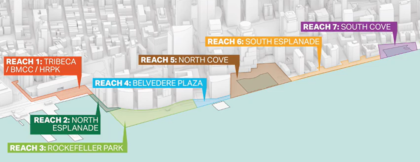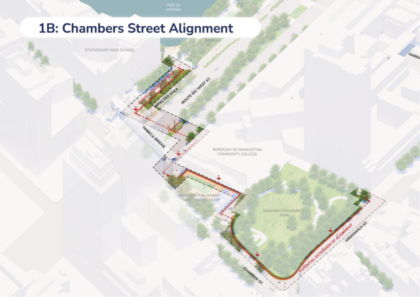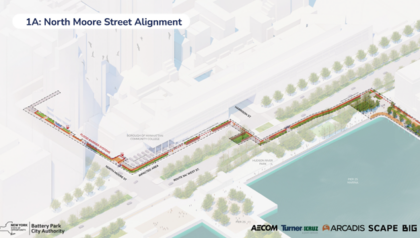Rockefeller reconstruction meetings start this week
I have a much more extensive post here if you want to dig in, but the thing to know now is that the Battery Park City Authority is hosting a series of workshops this month that will walk people through their plans to rebuild the waterfront from South Cove through Rockefeller Park and up into the streets of Tribeca north of Chambers. There are several options of varying degrees of complexity, so I think it will be really worthwhile to hear the plans explained in person — reading about it is numbing.
The last update to the plan was September 2022; you can flip through the PDF presentation here.
They have broken the area up into segments, and there will be a workshop for each one. Click to register:
- Rockefeller Park and Belvedere Plaza: Feb. 8, 6:30p, Stuyvesant High School cafeteria
- Tribeca/BMCC/Hudson River Park and North Esplanade: Feb. 16, 6:30p, Stuyvesant High School cafeteria
- South Esplanade and South Cove: info TBD
- North Cove: info TBD
To give you a quick take on what is on the table, there are plans to place flood barriers in both Hudson River Park and the streets of the neighborhood to keep river water from flowing in from the north of Battery Park City. They are suggesting four different routes for arrangements of 10-foot fixed flood walls along with a network of deployable barriers. These would reach as far as N. Moore and Greenwich.
And there are a few options for Rockefeller, including elevating the park or elevating the lawn only and installing floodwalls.
















So many of these proposals are just brutal—totally destructive of views, open space, mature trees, etc. Look at that South Cove view analysis on Page 36 of the September presentation.
People need to show up to these meetings and voice concern.
And didn’t the Save Wagner Park folks determine that the sea level/storm surge predictions used to guide all of these changes were wrong?
If we’re going to spend heaps of money thoughtfully planning for long-term sea level rise, the most sensible, lowest-impact solution would seem to be a combination (expensive) sea wall out in the harbor plus lots of (less expensive) natural mitigation measures on the shoreline (i.e., restored marshland, oyster beds, etc.) and within the metro area (i.e., permeable surfaces, bioswales, rain basins, etc.).
Unclear why the proposals to date consist primarily of piecemeal, human-agnostic concrete walls surrounding the entire city, which seems both inefficient/insufficient and severely diminishes the value of city life for residents.
This has to be one of the dumbest proposals I have ever seen. I agree with person, check out page 36 of the PDF. This plan just casually depicts how the marina and entire esplanade will be covered by a hideous concrete wall that destroys the river view and will make downtown NYC look like a prison yard. How in the hell can this be the best solution to the problem?
Battery Park City had only minimal damage from Hurricane Sandy, and the river’s level has only risen an inch since. Yet we supposedly need to spend a billion dollars to protect ourselves from…. what?
The BPCA doesn’t like to talk about the rationale for this, other than a lot of overheated rhetoric about potential “devastation” from “storm surges,” “rising seas,” and so on. It’s a Contractors Jamboree, and none of these unelected overseers will stop it.
This is an unwarranted destruction of a beautiful neighborhood. Such a shame.
I think its safe to say that Sandy-like flooding from natural weather events will increase in frequency due to global warming, but this doesn’t really seem like it’s the way to deal with that issue at all.
The main issues with the Sandy flooding were:
1) Holland/Lincoln tunnel and subway tunnel flooding
2) Vulnerable power grids
3) Some residential homes/buildings in flood zones that could be especially vulnerable
The remedy should be on addressing those issues, and that’s it. Who really cares if the parks or streets flood in BPC? The cost to repair those is a small fraction of the cost of this project, and it doesn’t completely destroy the natural beauty or utility of the waterfront.